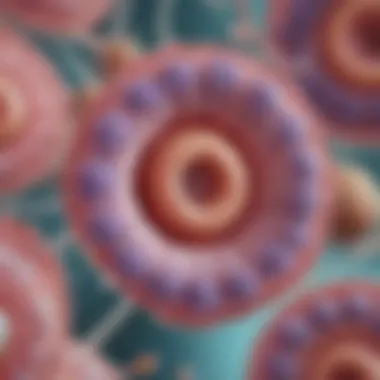Trichomonas Signs and Symptoms Explored


Intro
Trichomonas vaginalis is a significant protozoan parasite responsible for trichomoniasis, a common sexually transmitted infection (STI) affecting millions worldwide. Despite being a widespread concern, the signs and symptoms often go unnoticed or misdiagnosed, leading to untreated cases and extended health implications. Understanding these manifestations is crucial for both effective diagnosis and timely treatment.
In women, symptoms may include vaginal discharge, itching, and discomfort during urination. Men may exhibit fewer symptoms, but if present, they can consist of irritation or discharge from the urethra. This disparity highlights the necessity for awareness of gender-specific manifestations and their biological underpinnings.
The exploration of signs and symptoms associated with Trichomonas vaginalis is essential for medical professionals, educators, and students. It serves to improve recognition and management of the infection, while addressing the significant clinical implications that accompany it.
This article aims to outline the various symptoms encountered by infected individuals, discuss the underlying mechanisms of the parasite, and detail both the clinical challenges and implications of diagnosis.
Ultimately, identifying the nuances of Trichomonas signs and symptoms can contribute to more effective public health strategies and enhance individual health outcomes.
Preface to Trichomonas Vaginalis
Understanding Trichomonas vaginalis is essential due to its significant public health implications. This protozoan parasite is one of the most common sexually transmitted infections (STIs) worldwide. It can affect both men and women, often without noticeable symptoms. Thus, awareness of the signs and symptoms is crucial for timely diagnosis and treatment.
The examination of Trichomonas vaginalis encompasses various aspects such as its definition, epidemiology, symptoms, and complications. This section sets the stage for readers to appreciate the complexity and clinical relevance of the condition. Engaging with this material is beneficial not only for medical professionals and researchers but also for anyone interested in aspects of infectious diseases.
By focusing on specific elements such as epidemiology, this article underscores not only how prevalent this infection is but also the pathways through which it spreads. Knowledge of these factors can facilitate better public health strategies and personal health decisions.
Definition and Overview
Trichomonas vaginalis is a flagellated protozoan parasite that primarily resides in the urogenital tract. It causes trichomoniasis, which manifests most commonly as a sexually transmitted infection. The organism itself is characterized by its unique structure enabling mobility, thanks to its flagella. Its detection is essential for preventing complications and the spread of infection.
Trichomonas vaginalis often coexists with other pathogens, leading to a more complex clinical picture. While many infected individuals remain asymptomatic, some develop significant symptoms that can affect their overall health and well-being. Thus, understanding the definition and implications of Trichomonas vaginalis lays an important foundation for further exploration of trichomoniasis.
Epidemiology
The epidemiology of Trichomonas vaginalis is marked by its high prevalence, particularly among certain populations. It is estimated that millions of new cases occur each year globally. This infection is not limited by social or economic barriers but tends to be more prevalent in populations with limited access to healthcare and education about STIs.
Key points regarding the epidemiology of Trichomonas vaginalis include:
- Incidence Rates: Studies indicate that women are disproportionately affected compared to men, with higher rates observed in women aged 14 to 49.
- Risk Factors: Factors influencing the spread include multiple sexual partners, inconsistent condom use, and co-infection with other STIs, such as HIV.
- Geographical Variation: Infection rates vary across regions, influenced by cultural practices, healthcare access, and public health initiatives.
"Effective public health strategies are vital in addressing the high incidence of Trichomonas vaginalis. Understanding epidemiological trends can guide these efforts."
Understanding Symptoms
Understanding the signs and symptoms of Trichomonas vaginalis infection is vital for timely diagnosis and effective management. Recognizing potential manifestations can lead to better patient outcomes. Early identification of symptoms enables healthcare providers to recommend appropriate treatment strategies and prevent further complications.
The signs of trichomoniasis can often be subtle or easily mistaken for other conditions. Therefore, public awareness and education are crucial for encouraging individuals to seek medical attention if they suspect an infection.
Initial Signs of Infection
The initial signs of infection may include mild irritation or discomfort in the genital area. Some individuals may notice a change in vaginal discharge, which can become more frothy or have an unusual odor. This discharge can also be tinted yellow or green. Men may experience a feeling of itchiness or irritation at the tip of the penis or a slight discharge. Notably, these symptoms may not be universal; some infected individuals remain asymptomatic, making awareness even more imperative.
Common Symptoms in Males
In males, common symptoms of trichomoniasis can include:


- Urethritis: This is inflammation of the urethra, often causing burning during urination.
- Discharge: A discharge from the penis can occur, although it is less common than in females.
- Irritation: Some men report irritation around the head of the penis.
Men may also experience more general discomfort, which can lead to misdiagnosis if not carefully considered. The subtlety of these symptoms can contribute to the perpetuation of the infection, as untreated cases may go on to infect partners.
Common Symptoms in Females
In females, the symptoms tend to be more pronounced. Common manifestations include:
- Vaginal Discharge: A frothy, yellow-green discharge with a foul odor is prominent and may be profuse.
- Itching or Burning: Many women report itching within the genital region, along with burning sensations during urination or intercourse.
- Discomfort: Pain during sexual intercourse is also frequently noted.
- Swelling: In some cases, the vulva may appear swollen or inflamed.
It is important to note that the variability in symptoms can affect diagnosis, leading to delays in treatment. Some women might mistake these symptoms for a yeast infection or bacterial vaginosis, further complicating clinical evaluation.
Recognition of early symptoms combined with a comprehensive understanding can drive effective diagnosis and management of trichomoniasis.
Understanding these symptoms is key for both individuals and healthcare professionals. Prompt recognition can be the difference between managing a simple infection and dealing with severe complications. This focus on symptom awareness fosters better communication between patients and clinicians, ultimately leading to improved health outcomes.
Pathophysiology of Trichomoniasis
Understanding the pathophysiology of Trichomonas vaginalis is crucial. This knowledge helps in unraveling how the parasite interacts with its host and the consequent manifestations of infection. The cellular dynamics play a pivotal role, as do the immune responses that dictate the overall outcomes of the disease. By studying these interactions, we can better comprehend the complexities of clinical presentations and the potential complications arising from untreated infections.
How Trichomonas Affects the Body
Cellular Interaction
Cellular interaction is a fundamental aspect of how Trichomonas vaginalis infects the host. The parasite attaches to epithelial cells in the urogenital tract using its surface proteins. This is a critical characteristic, as this attachment facilitates subsequent invasion and colonization. The unique feature here is that Trichomonas not only survives but also thrives while evading host immune detection. This results in persistent inflammation, often leading to symptoms associated with trichomoniasis.
The advantages of understanding these cellular interactions are manifold. It allows for targeted treatments and therapies to interrupt the lifecycle of the parasite. Moreover, it provides insight into how to bolster the host's immune defenses. Further research in this area can yield more effective interventions to mitigate the effects of this infection.
Host Immune Response
The host immune response to Trichomonas vaginalis is another critical area of study. Once the parasite establishes itself, the immune system attempts to respond. A key characteristic of the host response is the recruitment of various immune cells to the site of infection. However, the unique feature of this interaction is that Trichomonas has developed strategies to evade immune detection, which can prolong the infection.
The advantages of learning about the immune response include better understanding how chronic infections develop and persist. Knowledge of the immune mechanisms at play can lead to novel therapeutic approaches aimed at enhancing the host defense mechanisms while reducing the parasite’s ability to evade them. This area remains an important consideration for those studying infectious diseases, particularly regarding treatment and prevention strategies.
Complications of Untreated Trichomoniasis
Untreated Trichomonas vaginalis infections can lead to several complications. These range from increased vulnerability to sexually transmitted infections to potential reproductive health issues such as infertility. In women, trichomoniasis has been associated with adverse pregnancy outcomes, including low birth weight or premature delivery. In men, there can be complications such as prostatitis. The chronic nature of the infection can also influence the psychological well-being of affected individuals. As the prevalence of trichomoniasis continues to be a public health concern, understanding these complications only emphasizes the necessity for timely diagnosis and intervention.
Gender-Specific Sign Manifestations
Gender-specific sign manifestations are crucial to understanding how Trichomonas vaginalis affects individuals differently. The importance of examining these variations lies in the fact that the male and female bodies not only respond to infections in distinct ways but also present different symptoms. These distinctions can influence clinical diagnosis, treatment decisions, and understanding of the potential complications that may arise later on. Additionally, recognizing gender-specific symptoms can enhance public health strategies aimed at preventing the spread of this infection. Understanding these manifestations allows healthcare providers to be more vigilant in identifying the presence of Trichomonas in both men and women, potentially leading to earlier intervention and better outcomes.
Male Symptoms: Distinctions and Significance
In males, the signs of Trichomonas infection can often appear subtle and might not always lead to immediate medical consultation. The most common symptom expressed is urethral discharge, which may be clear, cloudy, or yellowish. Men may also experience discomfort during urination or ejaculation. This is often accompanied by a burning sensation, which can feel alarming at first but is typically transient. Notably, many males may remain asymptomatic and thus unknowingly transmit the infection to sexual partners. This asymptomatic nature emphasizes the need for regular screening and the understanding that even without noticeable symptoms, the infection can still carry significant health risks.
The distinction of male-specific symptoms helps to clarify the routes of transmission and highlights the crucial aspect of sexual partners being tested. Early detection through proper evaluation, even when symptoms are not present, is significant for public health efforts.
Female Symptoms: Variability in Presentation


In contrast, females tend to exhibit a broader range of signs and symptoms. While some may present with vaginal discharge, which often has a foul odor, others might complain of itching, burning, or discomfort during intercourse. Unlike males, women usually experience a more notable variety of presentation, which can sometimes lead to misdiagnosis or confusion with other conditions such as bacterial vaginosis or yeast infections.
Additionally, the menstrual cycle may affect symptom severity. For some women, experiencing symptoms during menstruation can lead to misunderstanding, as symptoms can naturally fluctuate throughout the cycle. Other underlying conditions can also play a role in the variability of symptoms in women, making it essential for healthcare providers to evaluate and consider patients' individual health histories. This ensures a more tailored approach to treatment and management.
Recognizing the variations in female symptomatology is important for improving diagnosis and treatment protocols for Trichomonas infections.
Ultimately, understanding the differences in symptoms between genders not only assists in individual patient management but also strengthens the overall understanding of Trichomonas vaginalis within the context of sexually transmitted infections.
Diagnostic Approaches
The section on diagnostic approaches plays a critical role in understanding Trichomonas vaginalis infections. Proper diagnosis is essential for initiating effective treatment and preventing complications. This section emphasizes both clinical assessments and laboratory testing, underlining their significance in achieving accurate results.
Clinical Assessment and Patient History
The initial step in diagnosing Trichomonas is through a thorough clinical assessment. Medical professionals must gather comprehensive patient histories to understand potential risk factors. This includes reviewing sexual history, the presence of symptoms, and any previous infections.
Furthermore, clinicians should pay attention to any recent changes in sexual partners or engagement in unprotected sex. Recognizing patterns in a patient's history can significantly aid in forming a preliminary diagnosis.
Symptoms such as unusual discharge, itching, or irritation may point towards a Trichomonas infection. Thus, understanding these signs early leads to quicker interventions and better health outcomes. Taking a detailed account of the patient's history is invaluable in establishing a context for the infection.
Laboratory Testing and Techniques
Laboratory diagnostics are indispensable for confirming cases of Trichomonas. Various techniques are utilized, with microscopy and nucleic acid amplification tests being the most prominent.
Microscopy
Microscopy serves as a traditional yet effective method for diagnosing Trichomonas. This technique involves examining a sample of vaginal or urethral discharge under a microscope, allowing for the direct identification of the parasite.
A key characteristic of microscopy is its immediacy. Healthcare providers can render results quickly, which is crucial for timely treatment. Moreover, this technique is cost-effective and widely available in many health facilities.
However, microscopy does have limitations. For example, it requires skilled personnel to interpret findings accurately. Additionally, the sensitivity can vary based on the sample quality and timing. Despite these disadvantages, microscopy remains a cornerstone in the initial diagnostic processes of Trichomonas infections.
Nucleic Acid Amplification Tests
Nucleic Acid Amplification Tests (NAATs) represent a modern advancement in the diagnostic evaluation of Trichomonas. This technique focuses on detecting the genetic material of the organism, providing a high level of sensitivity and specificity.
The primary characteristic of NAATs is their robustness. They can identify the infection even when the parasite is present in low quantities. This feature makes NAATs particularly beneficial for asymptomatic cases, where traditional approaches may fail to detect the infection.
However, the disadvantages of NAATs include higher costs and the requirement for specialized laboratory settings. Moreover, while they are highly effective, their availability may not be as widespread as microscopy in all healthcare environments.
In summary, diagnostic approaches for Trichomonas infections are multifaceted. A combination of clinical assessment, microscopy, and nucleic acid amplification tests provides the most reliable framework for accurate diagnosis.
Treatment Options and Management
Treatment for Trichomonas vaginalis infection is imperative for several reasons. Effective management can alleviate symptoms, prevent complications, and stop the spread of the infection to partners. Identifying appropriate treatment methods is crucial not only for the affected individuals but also for public health, as the infection is easily transmissible. Knowledge about treatment options equips healthcare providers with the necessary tools to respond to an outbreak effectively. Therefore, this section outlines pharmacological interventions and the need to address co-infections.
Pharmacological Interventions
The first line of treatment for trichomoniasis typically involves antifungal medications. Metronidazole is the most frequently prescribed medication for this condition. It is effective, with a cure rate of nearly 95%. Tinidazole is another option that is similarly effective. Both treatments usually require a single dose or a short course depending on the clinician's discretion. Patients often experience relief of symptoms within days, although it is essential to complete the full regimen to avoid relapse.


Some important considerations when using these medications include:
- Drug Interactions: Patients should disclose all medications they are taking to avoid adverse reactions.
- Side Effects: Common side effects can include nausea, headache, and dizziness.
- Alcohol Avoidance: Drinking alcohol while on metronidazole can cause severe nausea and vomiting.
Following treatment, healthcare providers often recommend a follow-up test to ensure that the infection has been cleared completely, especially if symptoms persist or recur.
Addressing Co-Infections
Co-infections with other sexually transmitted infections (STIs) such as gonorrhea or chlamydia are not uncommon in individuals with trichomoniasis. This situation can complicate the treatment plan. Therefore, it is essential to screen for other STIs in individuals diagnosed with trichomoniasis. Treating these co-infections simultaneously can lead to a better health outcome and reduce the risk of complications.
Important points regarding co-infections include:
- Concurrent Treatment: Initiating treatment for multiple STIs helps minimize the risk of complications and further transmission.
- Patient Education: Patients should be educated on the importance of screening and treating co-infections.
- Partnerships in Treatment: Encourage partners of infected individuals to also get tested and treated, preserving community health.
In summary, thorough treatment options and management strategies are essential in addressing Trichomonas vaginalis infections. The focus should not only be on the individual but also on the broader implications for partners and the community.
Preventative Strategies
Preventive strategies are critical when it comes to managing the risks associated with Trichomonas vaginalis infection. Such strategies help reduce the transmission of this parasitic infection among both men and women, ultimately lessening the burden on healthcare systems. By emphasizing education, awareness, and proactive health measures, we can effectively combat this persistent health concern.
One significant aspect of prevention is understanding the modes through which Trichomonas is transmitted and implementing effective public health interventions. For instance, community-based education programs can enhance awareness of the infection's risks. People ought to know that Trichomonas is primarily spread through sexual contact, which means that educating individuals about safe-sex practices is vital.
Additionally, strategies focused on routine screenings can aid in the early detection of the infection, even in asymptomatic individuals. This is particularly relevant for groups at higher risk, including sexually active individuals and those with multiple partners.
"Prevention is far more effective than treatment after the fact. Educating communities about Trichomonas and its implications can save lives."
Public Health Recommendations
Public health organizations can play an important role in the prevention of Trichomonas infections. This includes:
- Promoting Safe Sex Practices: Health promotions should include information about the use of condoms, which can significantly reduce the risk of transmitting Trichomonas and other sexually transmitted infections (STIs).
- Routine Screening Campaigns: Encourage sexually active individuals, particularly women, to undergo regular screenings. This can help identify infections early and reduce further complications.
- Community Outreach Programs: Public health departments should focus on outreach in community centers, clinics, and schools to spread awareness. Accessible informational materials and workshops can facilitate understanding of Trichomonas and its consequences.
Personal Health Practices
On a personal level, individuals can take specific actions to reduce the risk of Trichomonas infection:
- Engaging in Mutual Monogamy: Limiting the number of sexual partners can notably decrease the chances of infection. If both partners engage in mutual fidelity, the risk is significantly diminished.
- Regular Check-Ups: Schedule check-ups with healthcare professionals. Regular assessments can help in early detection and treatment of the infections.
- Avoiding Substance Abuse: Reducing alcohol and drug use can enhance decision-making regarding sexual encounters, ultimately promoting safer practices.
- Fostering Open Communication: Encouraging honest conversations with sexual partners about health history and STI status can lead to informed decision-making.
Culmination and Future Directions
In examining Trichomonas vaginalis, it becomes evident that understanding its signs and symptoms is crucial for timely diagnosis and effective treatment. This microorganism, while often overlooked, poses significant health risks. The concluding section offers insights into the key findings detailed in the article, as well as recommendations for future research in the field.
Summary of Key Findings
The article highlights several key findings regarding Trichomonas vaginalis:
- Prevalence in both genders: The symptoms can vary widely between men and women, affecting the overall diagnosis and treatment pathways.
- Diverse manifestations: Initial signs include a range of symptoms that may mislead healthcare providers, leading to misdiagnosis or delayed treatment.
- Risk of complications: If left untreated, the infection may result in more severe health issues, including increased susceptibility to other sexually transmitted infections.
- Importance of public health initiatives: Effective educational campaigns can significantly reduce the transmission rates of Trichomonas.
These insights underline the necessity for healthcare providers to remain vigilant. Understanding these aspects can aid in shaping more effective management strategies for Trichomonas infections.
Areas for Further Research
Future studies should continue to explore the complexities of Trichomonas vaginalis, focusing on:
- Longitudinal studies on symptomatology: A deeper understanding of how symptoms progress in infected individuals can aid early detection.
- Impact of treatment regimens: Examining various treatment options and their efficacy over time can lead to optimized approaches for managing this infection.
- Role of immunity: Investigating how host immune responses interact with Trichomonas can provide insights into prevention and potential vaccines.
- Social factors: Further research into the socio-economic and cultural factors influencing infection rates can enhance public health strategies.















